|
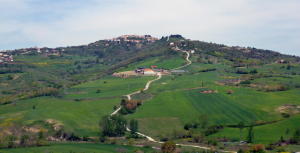 We
left Rome at 7:45 am for the bus ride to the Puglia region of Italy.
The drive took us down towards Naples, then across the Apenine Mountains
through the Alban Hills to the heel of the boot along the Adriatic
Sea. The picturesque countryside was full of huge wheat fields,
wine vineyards and olive tree farms. There are 16M olive trees in
Puglia, greater than the number of people in all of Italy. Towns
were nestled on hilltops. We
left Rome at 7:45 am for the bus ride to the Puglia region of Italy.
The drive took us down towards Naples, then across the Apenine Mountains
through the Alban Hills to the heel of the boot along the Adriatic
Sea. The picturesque countryside was full of huge wheat fields,
wine vineyards and olive tree farms. There are 16M olive trees in
Puglia, greater than the number of people in all of Italy. Towns
were nestled on hilltops.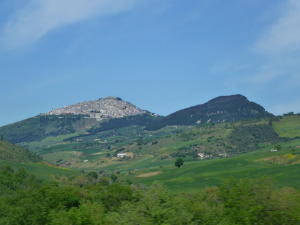 Initially these were fortified houses (Casteli) for the noble families
to escape from the feudal conflicts, but they later grew to small
villages.
Initially these were fortified houses (Casteli) for the noble families
to escape from the feudal conflicts, but they later grew to small
villages.
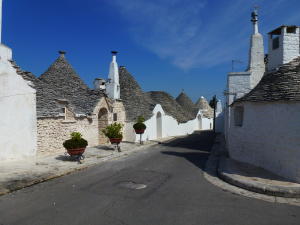 The
region is noted for its strange white Trulli buildings. We toured
the largest concentration of Trulli in the town of Alberobello.
It was declared a UNESCO World Heritage Site in 1996 because it
is a remarkable survival of prehistoric building techniques. Trulli
are circular structures with conical roofs built with local limestone
and stacked without using mortar, a technique called dry stone masonry. The
region is noted for its strange white Trulli buildings. We toured
the largest concentration of Trulli in the town of Alberobello.
It was declared a UNESCO World Heritage Site in 1996 because it
is a remarkable survival of prehistoric building techniques. Trulli
are circular structures with conical roofs built with local limestone
and stacked without using mortar, a technique called dry stone masonry.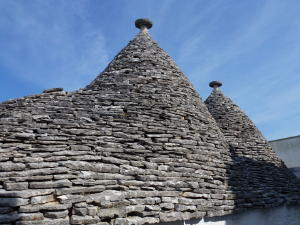 The first Trulli were built in the 12th century BC and were used
as tombs. Because the walls are at least 3 feet thick, the structures
are well insulated and no moisture gets inside. They were later
used as storage or for temporary shelters while farmers were away
from home. Later they were used for housing because they could be
dismantled at a moment's notice. This was necessary to avoid taxation
on new settlements. This is known to have occurred in 1644 to thwart
tax inspectors sent by the King of Naples.
The first Trulli were built in the 12th century BC and were used
as tombs. Because the walls are at least 3 feet thick, the structures
are well insulated and no moisture gets inside. They were later
used as storage or for temporary shelters while farmers were away
from home. Later they were used for housing because they could be
dismantled at a moment's notice. This was necessary to avoid taxation
on new settlements. This is known to have occurred in 1644 to thwart
tax inspectors sent by the King of Naples.
The Trulli were constructed using roughly worked limestone boulders
collected from neighboring fields and, later, the large water-collecting
basins in the area. They were built directly on the underlying natural
rock, using exclusively the dry stone technique. This area is the
only one with the right kind of limestone for building a Trulli.
The limestone in this region delaminates naturally at the right
rate.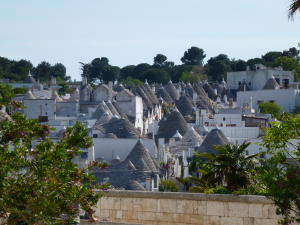 Initially, a round cistern is dug in the ground, about 9 feet in
diameter. The Trulli is built on top using wooden scaffolding to
hold the limestone rings of the cone. These are built up of successive
courses of grey limestone slabs, known as chianche or chiancarelle
. Then the large stones are placed under the cone for the sides.
Initially, a round cistern is dug in the ground, about 9 feet in
diameter. The Trulli is built on top using wooden scaffolding to
hold the limestone rings of the cone. These are built up of successive
courses of grey limestone slabs, known as chianche or chiancarelle
. Then the large stones are placed under the cone for the sides. Fireplaces, ovens and alcoves are recessed into the thickness of
the walls. Rain water is collected and stored in the cistern. Initially,
the limestone is white, turning grey as it ages and fractures.The
outside stone walls were often whitewashed. Until recent times,
when some of the Trulli have been upgraded for housing and vacation
cottages, there was no plumbing or electricity and sewage ran through
the streets. It is now illegal to live in a Trulli unless it has
been renovated.
Fireplaces, ovens and alcoves are recessed into the thickness of
the walls. Rain water is collected and stored in the cistern. Initially,
the limestone is white, turning grey as it ages and fractures.The
outside stone walls were often whitewashed. Until recent times,
when some of the Trulli have been upgraded for housing and vacation
cottages, there was no plumbing or electricity and sewage ran through
the streets. It is now illegal to live in a Trulli unless it has
been renovated.
 In
the evening, we took an optional tour for dinner at a Masseria.
These were originally fortified farms to protect them from marauders.
Now they have been turned into restaurants and small inns. 80% of
the food served is grown on their farm. The dinner was amazing,
starting with multiple dishes of antipasto. Then a pasta course
followed by a meat course and dessert pastries. Local wine was included
and was excellent. It was a long day and with all that food and
wine, we were happy to return to the hotel for a good night's rest. In
the evening, we took an optional tour for dinner at a Masseria.
These were originally fortified farms to protect them from marauders.
Now they have been turned into restaurants and small inns. 80% of
the food served is grown on their farm. The dinner was amazing,
starting with multiple dishes of antipasto. Then a pasta course
followed by a meat course and dessert pastries. Local wine was included
and was excellent. It was a long day and with all that food and
wine, we were happy to return to the hotel for a good night's rest.
Our hotel for the next two nights was the Chiusa di Chietri. The grounds were beautiful, with some modern Trulli for rent, an
outdoor swimming pool, and several lush garden areas which are used
for weddings and parties.
The grounds were beautiful, with some modern Trulli for rent, an
outdoor swimming pool, and several lush garden areas which are used
for weddings and parties.
To view more photos from Alberobello, please go to Alberobello
Photo Gallery. To read about the next location visited, go to
Matera.
Home
Locations Visited Photos Map
Contact Us
|
